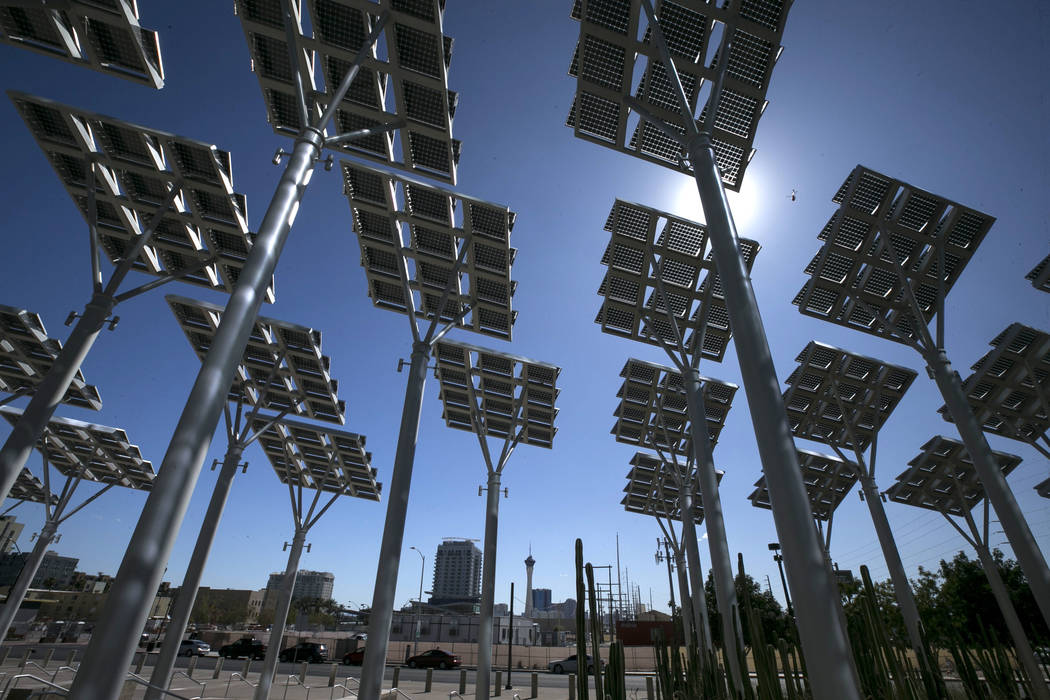Nevada ranks 3rd for solar installation in the US
Just two years after Nevada reinstated net metering, the state is breaking into the top rankings for solar installation in the U.S.
A recent report from Wood Mackenzie and the Solar Energy Industries Association found Nevada installed the third-highest amount of solar in the first quarter of 2019, behind only Florida and California.
“People are starting to understand solar is a truer, tested method of energy,” said Guy Snow, president of Solar NV, a local chapter of the American Solar Energy Society nonprofit solar advocacy group.
But the report also predicts Nevada’s growth will dwindle in about four years as the amount of net metering credit continues to decline, bringing down ratepayers’ financial incentive to install solar with it.
Rebound
The report found Nevada installed 293 megawatts of solar in the first quarter of 2019 alone. Last year, the state installed 550 megawatts. The amount is derived from utility and residential and nonresidential rooftop installation.
The local solar industry’s standing today is vastly different than just three years ago.
At the end of 2015, the Nevada Public Utilities Commission voted in favor of a new tariff structure that reduced net metering rates — the rates NV Energy pays to buy back excess energy generated by those with rooftop solar.
After the decision, the state lost about 400 solar jobs, according to The Solar Foundation. It lost another 1,800 between 2016 and 2017. After then-Gov. Brian Sandoval signed a bill that restored the state’s net metering in 2017, the industry began to rebound.
“It’s good news for the state because local installations mean local jobs,” said Sean Gallagher, vice president of state affairs for the SEIA.
Adding jobs
Andrea Vigil, chief operating officer of local solar installation company Allegiant Electric, has seen that local job growth within her own company.
She started the company in 2017 with her husband. Since then, the company has hired 11 employees to keep up with demand, Vigil said.

The business got another boost after last year’s general election, Vigil said, when voters passed Question 6. It was the first step in establishing a renewable portfolio standard that would require the state to acquire half its electricity from renewable resources by 2030.
“I think people are confident in the (solar) industry,” Vigil said. “You’re seeing a lot more customers calling and wanting to add additional panels.”
Vigil expects the growth to continue as more construction projects and developments pop up across the valley.
“It’s really an exciting time,” she said.
But the explosive growth might come to an end soon, the report cautioned.
Net metering tiers
NV Energy operates its net metering structure with a tiered system set to decrease solar reimbursements over time.
The compensation decline was designed to ensure non-solar customers are not harmed by the net metering system as more customers turn to solar using NV Energy’s grid. The decline in credit ensures solar customers contribute to the upkeep of the grid system, including transmission lines.
The tiered system was laid out in Assembly Bill 405, which the Legislature passed in 2017. The first tier was set for customers who agreed to net metering on or after June 15, 2017, and was in effect until the amount of electricity produced by customers in this tier hit 80 megawatts. This tier credited customers for the excess energy produced at 95 percent of the retail electricity.
The next tier — which NV Energy is accepting applications for — dropped to 88 percent. The final two tiers will credit at 81 percent and then 75 percent as production hits each 80-megawatt benchmark.
“As the amount of solar increases, the compensation goes down,” Gallagher said.
The report expects Nevada’s residential solar installation growth rate to be stable before slowing down after 2022.
“Folks that are installing solar in later (tier) blocks are going to be receiving less money,” Wood Mackenzie Solar Analyst Austin Perea said. “The value proposition is going to become less attractive.”
Perea said a step down of federal solar investment tax credits that year will also hit the industry’s growth. But Gallagher said that a slowdown doesn’t erase the strides Nevada’s solar industry has already made.
“It certainly doesn’t go away,” Gallagher said. “If we can bring the cost (of solar) down, we can improve that profile.”
This story has been updated to reflect the accurate name of the renewable portfolio standard ballot question.
Contact Bailey Schulz at bschulz@reviewjournal.com or 702-383-0233. Follow @bailey_schulz on Twitter.




















